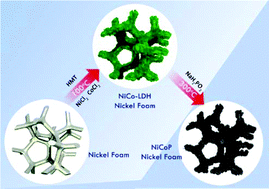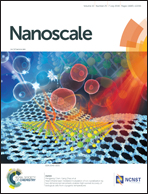Phosphorization boosts the capacitance of mixed metal nanosheet arrays for high performance supercapacitor electrodes†
Abstract
Binary transition metal phosphides hold immense potential as innovative electrode materials for constructing high-performance energy storage devices. Herein, porous binary nickel–cobalt phosphide (NiCoP) nanosheet arrays anchored on nickel foam (NF) were rationally designed as self-supported binder-free electrodes with high supercapacitance performance. Taking the combined advantages of compositional features and array architectures, the nickel foam supported NiCoP nanosheet array (NiCoP@NF) electrode possesses superior electrochemical performance in comparison with Ni-Co LDH@NF and NiCoO2@NF electrodes. The NiCoP@NF electrode shows an ultrahigh specific capacitance of 2143 F g−1 at 1 A g−1 and retained 1615 F g−1 even at 20 A g−1, showing excellent rate performance. Furthermore, a binder-free all-solid-state asymmetric supercapacitor device is designed, which exhibits a high energy density of 27 W h kg−1 at a power density of 647 W kg−1. The hierarchical binary nickel–cobalt phosphide nanosheet arrays hold great promise as advanced electrode materials for supercapacitors with high electrochemical performance.



 Please wait while we load your content...
Please wait while we load your content...